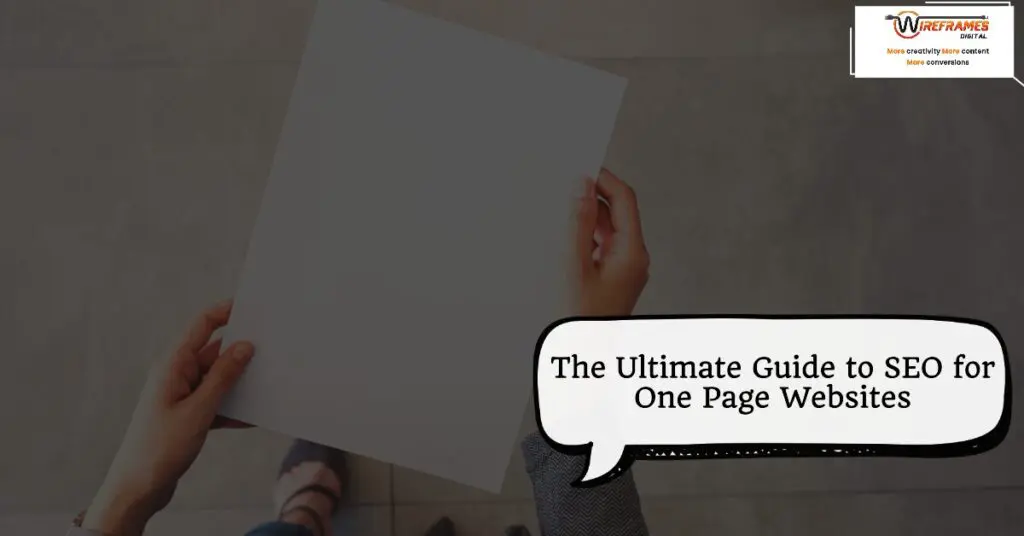Introduction
What is SEO?
Search Engine Optimization (SEO) is the practice of improving the quality and quantity of website traffic by increasing the visibility of a website to users of a web search engine. SEO is essential because it helps websites rank higher on search engine results pages (SERPs), making them more likely to be visited by users. This increased visibility translates to more traffic and potential conversions.
Understanding One Page Websites
A one-page website, as the name suggests, contains all the information on a single page. Users navigate to different sections of the page via internal links, often with smooth scrolling effects. This design approach is popular in industries like portfolios, landing pages, event promotions, and small businesses looking for a streamlined web presence.
Characteristics of One Page Websites
- Minimalistic Design: Emphasizes simplicity and a clean user interface.
- Focused Content: Presents information concisely and directly.
- Smooth Navigation: Uses internal linking and anchor tags for seamless browsing.
Advantages of One Page Websites
- User Experience: Enhanced user experience with easy navigation.
- Mobile-Friendly: Easier to optimize for mobile devices.
- Conversion Rate: Direct call-to-actions leading to potentially higher conversion rates.
Challenges of One Page Websites
- Keyword Density: Limited space to include all relevant keywords.
- SEO Competition: May find it challenging to compete with multi-page websites.
- Content Limitation: Difficulty in providing extensive information without overwhelming the user.
Keyword Research and Strategy
Identifying Core Keywords
Effective SEO for one page websites starts with robust keyword research. Core keywords are the backbone of any SEO strategy. Utilize tools like Google Keyword Planner, Ahrefs, and SEMrush to identify high-ranking keywords in your niche. A good mix of long-tail keywords (more specific phrases) and short-tail keywords (broader terms) will ensure diverse traffic sources.
Utilizing LSI Keywords
Latent Semantic Indexing (LSI) keywords are terms related to your primary keyword. They help search engines understand the context of your content, making your page more relevant to user queries. Integrating LSI keywords prevents keyword stuffing and ensures your content reads naturally. Tools like LSIGraph can assist in finding these related terms.
Checkout Importance of Zero Search Volume Keywords and why one should consider it.
On-Page SEO Techniques
Optimizing Title and Meta Descriptions
The title tag and meta description are the first elements users encounter on SERPs. Crafting compelling and keyword-rich titles and descriptions will entice users to click through to your website.
- Title Tag: Should include the primary keyword and be within 60 characters.
- Meta Description: Summarize your content adequately and integrate core keywords naturally. Aim to keep it within 160 characters.
Content Structuring and Use of Header Tags
Proper content structuring is fundamental for user experience and SEO for one page websites. Utilize header tags (H1, H2, H3) to organize content hierarchically. The H1 tag should contain the primary keyword, while H2 and H3 tags can incorporate LSI keywords and other relevant terms.
Keyword Optimization
Keyword optimization is crucial but should be done organically to maintain readability. The primary keyword should appear in key areas like the title tag, headings, and the first 100 words of the content. Avoid keyword stuffing, as it can negatively impact user experience and search engine rankings.
Optimizing Images and Media
Images and media are vital for user engagement. However, they can slow down your page load speed.
- Alt Text: Use descriptive alt text that includes keywords.
- Image Compression: Optimize images to decrease load time without compromising quality.
- Lazy Loading: Implement lazy loading so that images load as users scroll down the page, enhancing page speed and user experience.
Technical SEO for One Page Websites
Improving Page Load Speed
Page load speed is a critical ranking factor. A fast-loading site provides a better user experience, reducing bounce rates.
- Measure Load Speed: Use tools like Google PageSpeed Insights and GTmetrix to identify areas of improvement.
- Optimizing Techniques: Minimize CSS and JavaScript files, use browser caching, and optimize server response time.
Mobile-Friendliness
With the majority of users accessing websites through mobile devices, ensuring that your one-page website is mobile-friendly is crucial.
- Responsive Design: Ensure your website adapts seamlessly to different screen sizes.
- Mobile Usability Testing: Use tools like Google’s Mobile-Friendly Test to identify and fix mobile usability issues.
Secure and Accessible URL
A secure (HTTPS) and accessible URL is vital for both user trust and SEO for one page websites.
- HTTPS: Use an SSL certificate to secure your website.
- Clean URLs: Ensure your URLs are clean and descriptive. Avoid lengthy and confusing URLs.
- Canonical Tags: Use canonical tags to prevent duplicate content issues, especially if your content is accessible through multiple URLs.
Off-Page SEO and Link-Building
Building High-Quality Backlinks
Backlinks are external links from other websites to your one-page site. They are one of the most important factors in Google’s ranking algorithm.
- Quality Over Quantity: Focus on acquiring backlinks from high-authority sites.
- Guest Posting: Write high-quality guest posts for reputable websites in your industry.
- Avoid Black-Hat Techniques: Avoid using manipulative practices like buying links, which can lead to penalties.
Leveraging Social Media
Social media can amplify your SEO efforts by driving traffic and increasing engagement.
- Content Promotion: Share your content on various social media platforms.
- User Engagement: Increase audience interaction with likes, shares, and comments.
- Brand Awareness: Build your brand presence to encourage organic backlinks and traffic.
Measuring and Analyzing SEO Performance
Using Google Analytics
Google Analytics provides invaluable insights into your website’s performance.
- Setup: Set up Google Analytics to track your one-page website’s traffic.
- Key Metrics: Monitor metrics like bounce rate, session duration, and pages per session.
- Improvement: Use the data to identify areas of improvement and measure the impact of your SEO efforts.
Search Console Insights
Google Search Console is another essential tool for monitoring and optimizing your SEO for one page websites.
- Performance Monitoring: Check how your website is performing in Google Search.
- Coverage Issues: Identify and fix any coverage issues that could be affecting your indexation.
- Search Analytics: See which queries bring users to your site and optimize accordingly.
Frequently Asked Questions (FAQ)
Can a One Page Website Rank Well on Google?
Yes, a one-page website can rank well on Google. However, it requires carefully crafted content and a sound SEO strategy to compete with multi-page sites. Focus on keyword-rich, high-quality content, user experience, and acquiring authoritative backlinks.
Is a One Page Website Suitable for All Businesses?
A one-page website is ideal for businesses that do not require extensive content to convey their message, such as creatives, consultants, and event promotions. However, industries needing detailed information or multiple service pages may find a multi-page website more suitable.
How Often Should I Update my One Page Website for SEO?
Regular updates are essential to keep the content relevant and fresh, which is beneficial for SEO. Aim to update your content every few months, reflecting the latest information, news, and trends in your industry.
Can I Use Blog Posts on a One Page Website?
While traditional blogging may not fit a one-page design, you can use expandable sections, tabs, or accordions to incorporate blog-to style content. This allows you to provide valuable information without cluttering the page.
What are the Biggest Mistakes to Avoid in One Page SEO?
Common mistakes include keyword stuffing, neglecting technical SEO, slow page load speed, lack of mobile optimization, and ignoring backlink opportunities. Always focus on user experience, high-quality content, and keeping up with the latest SEO trends.
Conclusion
Continuous Improvement Strategies
SEO for one page websites is an ongoing effort. Regularly updating your content, monitoring performance, and adapting to the latest SEO trends are vital. Use analytics data to refine your strategies and maintain your site’s competitive edge.
Final Tips
In summary, an effective SEO strategy for one-page websites involves comprehensive keyword research, proper content structuring, technical optimization, and continuous improvement. By focusing on these areas, you can achieve higher search engine rankings and drive more traffic to your site. Remember, SEO is a marathon, not a sprint, and continuous learning and adaptation are key to long-term success.
Stay committed to your SEO efforts and watch your one-page website thrive in search engine rankings.
















